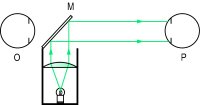Medical term:
retinoscope
retinoscope
[ret´ĭ-no-skōp″]skiascope; an instrument used in retinoscopy.
Miller-Keane Encyclopedia and Dictionary of Medicine, Nursing, and Allied Health, Seventh Edition. © 2003 by Saunders, an imprint of Elsevier, Inc. All rights reserved.
ret·i·no·scope
(ret'i-nō-skōp),An optic device used to illuminate a subject's retina during retinoscopy.
[retino- + G. skopeō, to view]
Farlex Partner Medical Dictionary © Farlex 2012
retinoscope
(rĕt′n-ə-skōp′)n.
An optical instrument for examining refraction of light in the eye. Also called skiascope.
The American Heritage® Medical Dictionary Copyright © 2007, 2004 by Houghton Mifflin Company. Published by Houghton Mifflin Company. All rights reserved.
ret·i·no·scope
(ret'i-nŏ-skōp)An optic device used to illuminate a patient's retina during retinoscopy.
[retino- + G. skopeō, to view]
Medical Dictionary for the Health Professions and Nursing © Farlex 2012
retinoscope
An optical instrument used to determine the state of refraction of the eye by RETINOSCOPY. It is not an instrument for examining the retina but a means of producing a light that is reflected from the retina. The direction of the movement of this light varies with the refraction and with lenses held in front of the eye.Collins Dictionary of Medicine © Robert M. Youngson 2004, 2005
retinoscope
An instrument for determining objectively the refractive state of the eye. It consists of a light source, a condensing lens and a mirror. The mirror is either semi-transparent or has a hole through which the retinoscopist can view the patient's eye along the retinoscope's beam of light. A patch of light is formed on the patient's retina and by moving that patch in a given direction and observing the direction in which it appears to move after refraction by the patient's eye, the retinoscopist can determine whether the patient's retina is focused in front of, at, or behind the retinoscope's sight hole. If the light reflected from the patient's fundus (called the retinoscopic reflex or light reflex) and observed in the patient's pupil through the retinoscope moves in the same direction as the movement of the mirror (this is referred to as a with movement), the eye is hyperopic. If the reflex moves in the opposite direction to that of the mirror (against movement), the eye is myopic. Sometimes it is impossible to see a clear movement one way or the other but only a bipartite reflex, showing opposite movements in the two sectors of the pupils (this is called a split reflex or a scissors movement). The refractive error is determined by placing lenses of various powers in front of the patient's eye until no movement is seen, i.e. the whole pupil is either illuminated or dark and the image of the patient's retina is then conjugate with the plane of the retinoscope's sight hole. When this phenomenon occurs the neutral point has been reached. The neutral point is measured for each principal meridian of the eye if it is astigmatic. To arrive at the patient's error of refraction the dioptric power corresponding to the distance between patient and retinoscope (called the working distance) is subtracted from the total lens power used to obtain neutralization. The amount of dioptric power subtracted is called the allowance. (Fig. R13) Syn. skiascope. See retinoscopic band; chromoretinoscopy; fundus reflex; velonoskiascopy.
spot retinoscope A retinoscope that projects a circular beam of light upon the patient's retina.
streak retinoscope A retinoscope that projects into the patient's eye an oblong streak, which can be adjusted in width and rotated in various meridians. It is more efficient than the spot retinoscope in determining astigmatism.

spot retinoscope A retinoscope that projects a circular beam of light upon the patient's retina.
streak retinoscope A retinoscope that projects into the patient's eye an oblong streak, which can be adjusted in width and rotated in various meridians. It is more efficient than the spot retinoscope in determining astigmatism.

Fig. R13 Optical principle of a retinoscope (O, observer's eye; P, patient's eye; M, semi-silvered mirror)
Millodot: Dictionary of Optometry and Visual Science, 7th edition. © 2009 Butterworth-Heinemann
Latest Searches:
anteorbital - Anorgasmy - anociassociation - ankerite - anitrogenous - anhydration - angiectomy - androgenesis - anconal - anatomical - anachoresis - amphigony - ammonification - aminometramide - aminolevulinic - ameburia - ameboma - ambitendencies - alternifolia - alopecia -
- Service manuals - MBI Corp